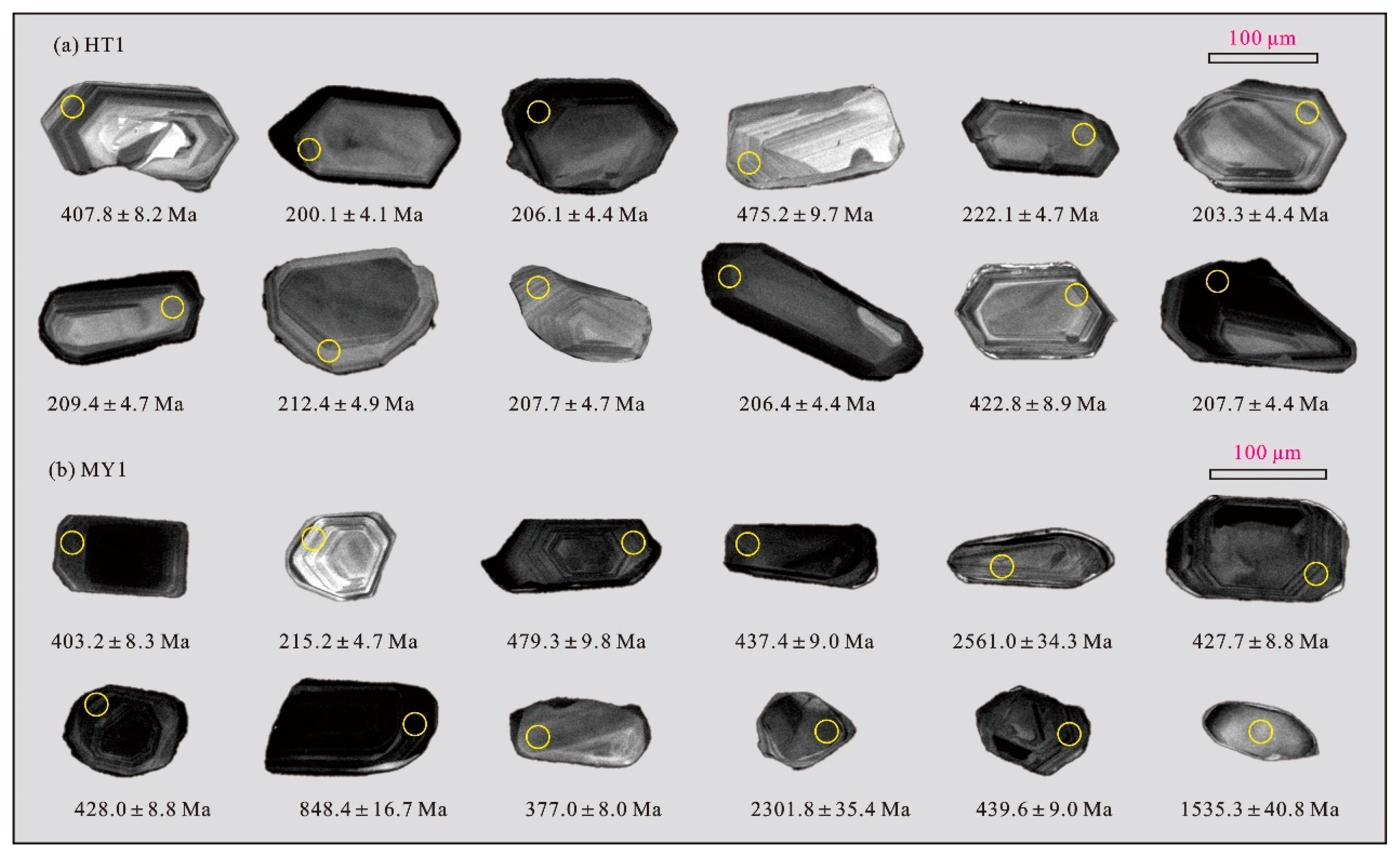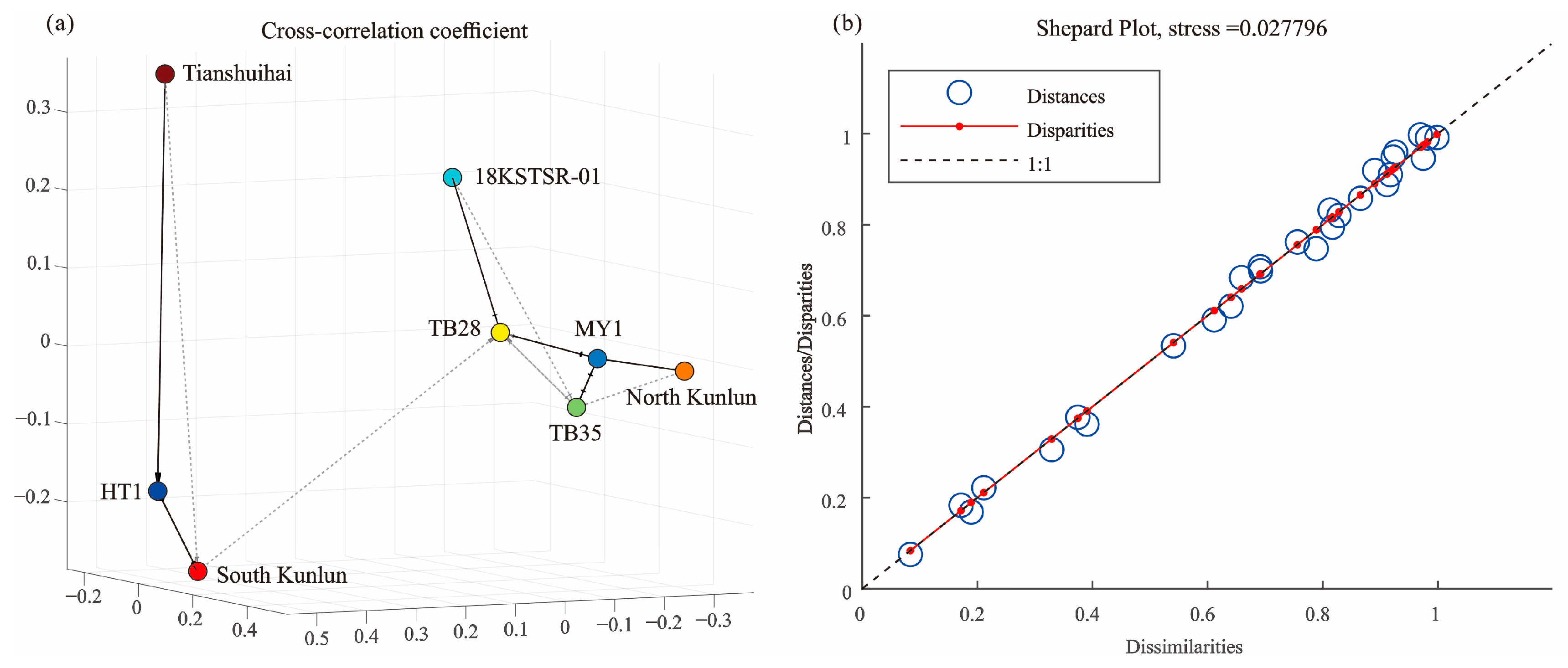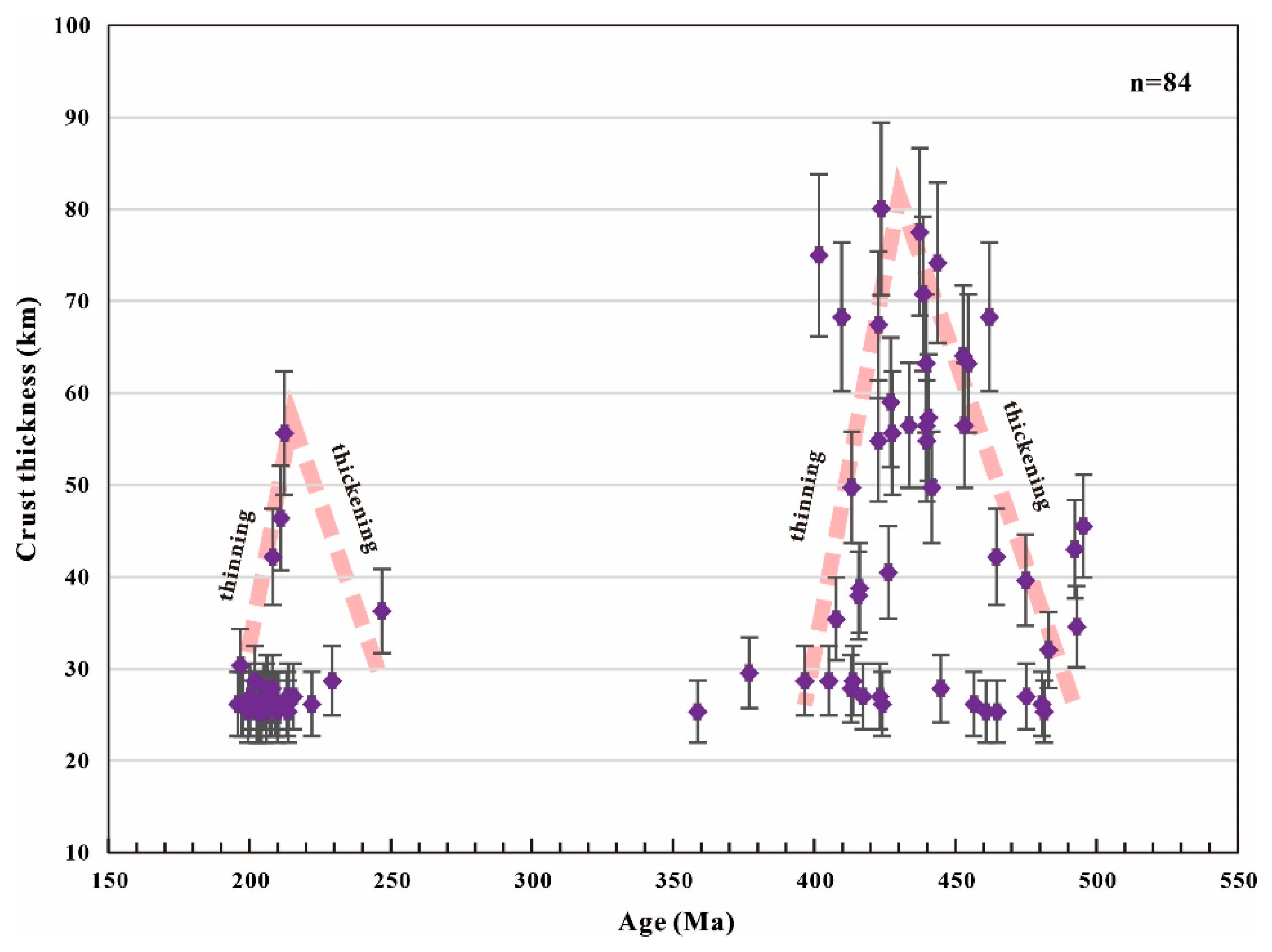Detrital Zircon U-Pb Geochronology of River Sands from the Yulongkash and Karakash Rivers in the Hotan River Drainage System, Southwestern Tarim Basin: Implications for Sedimentary Provenance and Tectonic Evolution
Abstract
1. Introduction
2. Geological Background
3. Sampling and Methodology
3.1. Sampling
3.2. Detrital Zircon Analytical Methods
4. Results
4.1. Detrital Zircon U-Pb Ages
4.2. Detrital Zircon Trace Elements
5. Discussions
5.1. Provenance Interpretation
5.2. Comparison with the Published Detrital Zircon Data of Modern River Sediment from the Hotan River Drainage System
5.3. Tectonic Implications
6. Conclusions
- (1)
- The findings reveal significant spatial variations in detrital zircon age spectra, which correlate with the geological heterogeneity of the source regions, including the North Kunlun, South Kunlun, and Tianshuihai terranes. The Yulongkash River predominantly receives sediments from the South Kunlun and Tianshuihai terranes, marked by Triassic (~208 Ma) and Early Paleozoic (~418 Ma) zircon populations. In contrast, the Karakash River sediments are largely derived from the North Kunlun Terrane, evidenced by Early Paleozoic (~460 Ma) and scattered Precambrian zircons.
- (2)
- The integration of our new data with previously published datasets reveals systematic downstream mixing of detrital signals, modulated by spatial heterogeneity in bedrock ages, fluvial geomorphology, and sediment mixing efficiencies. The Hotan River’s confluence zone exhibits transitional zircon age spectra, blending inputs from both tributaries while retaining subtle provenance biases. These results underscore the importance of detailed sampling and statistical analysis in reconstructing the complexities of sediment transport and provenance in tectonically active settings.
- (3)
- From a tectonic perspective, the study contributes to ongoing debates regarding the closure timing of the Paleo-Tethys and Proto-Tethys oceans in the WKOB. The crustal thickness reconstructions based on detrital zircon trace element data provide new constraints on the timing of orogenic events, suggesting that the terminal closure of the Proto-Tethys Ocean occurred around 420–440 Ma, with the closure of the Paleo-Tethys Ocean occurring during the Late Triassic (ca. 210 Ma).
Supplementary Materials
Author Contributions
Funding
Data Availability Statement
Acknowledgments
Conflicts of Interest
References
- Cao, K.; Wang, G.-C.; Bernet, M.; van der Beek, P.; Zhang, K.-X. Exhumation history of the West Kunlun Mountains, northwestern Tibet: Evidence for a long-lived, rejuvenated orogen. Earth Planet. Sci. Lett. 2015, 432, 391–403. [Google Scholar] [CrossRef]
- Matte, P. Tectonics of Western Tibet, between the Tarim and the Indus. Earth Planet. Sci. Lett. 1996, 142, 311–330. [Google Scholar] [CrossRef]
- Yin, A. Cenozoic tectonic evolution of Asia: A preliminary synthesis. Tectonophysics 2010, 488, 293–325. [Google Scholar] [CrossRef]
- Laborde, A.; Barrier, L.; Simoes, M.; Li, H.; Coudroy, T.; Van der Woerd, J.; Tapponnier, P. Cenozoic deformation of the Tarim Basin and surrounding ranges (Xinjiang, China): A regional overview. Earth-Sci. Rev. 2019, 197, 102891. [Google Scholar] [CrossRef]
- Rittner, M.; Vermeesch, P.; Carter, A.; Bird, A.; Stevens, T.; Garzanti, E.; Andò, S.; Vezzoli, G.; Dutt, R.; Xu, Z.; et al. The provenance of Taklamakan desert sand. Earth Planet. Sci. Lett. 2016, 437, 127–137. [Google Scholar] [CrossRef]
- Liang, S.; Lin, X.; Li, C.; Wei, X.; Qu, Y.; An, K.; Chen, C.; Yang, X.; Li, Y.; Zhang, L.; et al. Northward expansion of the West Kunlun orogenic belt during the Cenozoic and its implications for the evolution of the northwest Tibetan Plateau: Constraints from sediment dispersal patterns in the Buya Basin, China. Palaeogeogr. Palaeoclimatol. Palaeoecol. 2024, 647, 112255. [Google Scholar] [CrossRef]
- Chen, X.; Chen, H.; Lin, X.; Cheng, X.; Chen, C.; Rembe, J.; Zou, H. Late Cenozoic deformation of the northeastern Pamir and the west Kunlun Mountains: Insights from anisotropy of magnetic fabrics and sedimentary analysis. Palaeogeogr. Palaeoclimatol. Palaeoecol. 2024, 655, 112521. [Google Scholar] [CrossRef]
- Clift, P.D.; Zheng, H.; Carter, A.; Böning, P.; Jonell, T.; Schorr, H.; Shan, X.; Pahnke, K.; Wei, X.; Rittenour, T. Controls on erosion in the western Tarim Basin: Implications for the uplift of northwest Tibet and the Pamir Controls on erosion in the western Tarim Basin: Implications for the uplift of northwest Tibet and the Pamir. Geosphere 2017, 13, 1747–1765. [Google Scholar] [CrossRef]
- Sun, J.; Xiao, W.; Windley, B.F.; Ji, W.; Fu, B.; Wang, J.; Jin, C. Provenance change of sediment input in the northeastern foreland of Pamir related to collision of the Indian Plate with the Kohistan-Ladakh arc at around 47 Ma. Tectonics 2016, 35, 315–338. [Google Scholar] [CrossRef]
- Yang, W.; Fu, L.; Wu, C.; Song, Y.; Jiang, Z.; Luo, Q.; Zhang, Z. Journal of Asian Earth Sciences U-Pb ages of detrital zircon from Cenozoic sediments in the southwestern Tarim Basin, NW China: Implications for Eocene–Pliocene source-to-sink relations and new insights into Cretaceous–Paleogene magmatic sources. J. Asian Earth Sci. 2018, 156, 26–40. [Google Scholar] [CrossRef]
- Gehrels, G. Detrital Zircon U-Pb Geochronology Applied to Tectonics. Annu. Rev. Earth Planet. Sci. 2014, 42, 127–149. [Google Scholar] [CrossRef]
- Zhang, S.; Liu, C.; Bai, J.; Wang, J.; Ming, M.A.; Guan, Y.; Peng, H. Provenance Variability of the Triassic Strata in the Turpan-Hami Basin: Detrital Zircon Record of Indosinian Tectonic Reactivation in the Eastern Tianshan. Acta Geol. Sin. 2019, 93, 1850–1868. [Google Scholar] [CrossRef]
- Tang, J.; Zhang, Z.; Xue, J.; Liu, B.; Chen, Y.; Zhang, S. Permo-Carboniferous provenance shifts at the northern margin of the North China Craton and their tectonic implications: Detrital zircon U–Pb–Hf records from central Inner Mongolia. Gondwana Res. 2021, 95, 134–148. [Google Scholar] [CrossRef]
- Zhang, Z.; Sun, J.; Zhang, B.; Ren, Z. Cenozoic source-to-sink relations between the West Kunlun Mountains and SW Tarim Basin: Evidence from an integrated provenance analysis. Palaeogeogr. Palaeoclimatol. Palaeoecol. 2023, 632, 111858. [Google Scholar] [CrossRef]
- Wang, E.; Wan, J.; Liu, J. Late Cenozoic geological evolution of the foreland basin bordering the West Kunlun range in Pulu area: Constraints on timing of uplift of northern margin of the Tibetan Plateau. J. Geophys. Res. Solid Earth 2003, 108, 2401. [Google Scholar] [CrossRef]
- Cheng, X.; Chen, H.; Lin, X.; Wu, L.; Gong, J. Geometry and Kinematic Evolution of the Hotan-Tiklik Segment of the Western Kunlun Thrust Belt: Constrained by Structural Analyses and Apatite Fission Track Thermochronology. J. Geol. 2017, 125, 65–82. [Google Scholar] [CrossRef]
- Luo, H.; Xiong, F.; Huang, H.; Yan, D.; Zhang, D.; Li, F.; Hou, M. Provenance of Late Carboniferous–Triassic clastic rocks in the Western Kunlun orogenic belt, western China: Implications for the tectonic evolution of the Paleo-Tethys Ocean. J. Asian Earth Sci. 2024, 267, 106162. [Google Scholar] [CrossRef]
- Xiao, W.; Windley, B.; Hao, J.; Li, J. Arc-ophiolite obduction in the Western Kunlun Range (China): Implications for the Palaeozoic evolution of central Asia. J. Geol. Soc. 2002, 159, 517–528. [Google Scholar] [CrossRef]
- Mattern, F.; Schneider, W. Suturing of the Proto- and Paleo-Tethys oceans in the western Kunlun (Xinjiang, China). J. Asian Earth Sci. 2000, 18, 637–650. [Google Scholar] [CrossRef]
- Xiao, W.; Han, F.; Windley, B.F.; Yuan, C.; Zhou, H.; Li, J. Multiple Accretionary Orogenesis and Episodic Growth of Continents: Insights from the Western Kunlun Range, Central Asia. Int. Geol. Rev. 2003, 45, 303–328. [Google Scholar] [CrossRef]
- Wang, P.; Zhao, G.; Han, Y.; Liu, Q.; Yao, J.; Yu, S.; Li, J. Timing of the final closure of the Proto-Tethys Ocean: Constraints from provenance of early Paleozoic sedimentary rocks in West Kunlun, NW China. Gondwana Res. 2020, 84, 151–162. [Google Scholar] [CrossRef]
- Li, G.; Sandiford, M.; Fang, A.; Kohn, B.; Sandiford, D.; Fu, B.; Zhang, T.; Cao, Y.; Chen, F. Multi-stage exhumation history of the West Kunlun orogen and the amalgamation of the Tibetan Plateau. Earth Planet. Sci. Lett. 2019, 528, 115833. [Google Scholar] [CrossRef]
- Chang, J.; Liu, K.; Yuan, W.; Liu, J.; Zhang, L.; Chen, C. Tectono-sedimentary evolution of the southwestern Tarim Basin in the cretaceous in response to basin-range coupling: New insights from basin and landscape dynamics modeling. Palaeogeogr. Palaeoclimatol. Palaeoecol. 2024, 637, 112017. [Google Scholar] [CrossRef]
- Li, C.; Chen, H.; Zhang, F.; Lin, X.; Cheng, X.; Li, Y.; Chen, C.; Zhang, L.; Shang, J.; Sun, D.; et al. Cenozoic basin-filling evolution of the SW Tarim Basin and its implications for the uplift of western Kunlun: Insights from (seismo)stratigraphy. Palaeogeogr. Palaeoclimatol. Palaeoecol. 2021, 562, 110149. [Google Scholar] [CrossRef]
- Baby, G.; Simoes, M.; Barrier, L.; Guilbaud, C.; Li, H.; Van der Woerd, J. Kinematics of Cenozoic Shortening of the Hotan Anticline Along the Northwestern Margin of the Tibetan Plateau (Western Kunlun, China). Tectonics 2022, 41, e2021TC006928. [Google Scholar] [CrossRef]
- Fu, X.; Shen, B.; Dong, Z.; Zhang, X. Assessing the impacts of changing climate and human activities on streamflow in the Hotan River, China. J. Water Clim. Change 2020, 11, 166–177. [Google Scholar] [CrossRef]
- Vermeesch, P. IsoplotR: A free and open toolbox for geochronology. Geosci. Front. 2018, 9, 1479–1493. [Google Scholar] [CrossRef]
- Boynton, W.V. Cosmochemistry of the Rare Earth Elements: Meteorite Studies. Dev. Geochem. 1984, 2, 63–114. [Google Scholar]
- Wang, P.; Zhao, G.; Han, Y.; Liu, Q.; Yao, J.; Li, J. Petrogenesis of Ordovician granitoids in Western Kunlun, NW Tibetan Plateau: Insights into the evolution of the Proto-Tethys Ocean. Bulletin 2021, 133, 1071–1089. [Google Scholar] [CrossRef]
- Wang, K.; Wang, H.; Bai, H.; Gao, H.; Zhang, X.; Zhu, B.; Wang, Z.; Huang, L.; Zhang, S. Petrogenesis of the Late Triassic Habake granitic pluton, the West Kunlun Orogen, Western China: Tectonic implications for the evolution of the Paleo-Tethys. J. Asian Earth Sci. 2024, 266, 106130. [Google Scholar] [CrossRef]
- Saylor, J.E.; Sundell, K.E. Quantifying comparison of large detrital geochronology data sets. Geosphere 2016, 12, 203–220. [Google Scholar] [CrossRef]
- Saylor, J.E.; Jordan, J.C.; Sundell, K.E.; Wang, X.; Wang, S.; Deng, T. Topographic growth of the Jishi Shan and its impact on basin and hydrology evolution, NE Tibetan Plateau. Basin Res. 2018, 30, 544–563. [Google Scholar] [CrossRef]
- Castillo, P.; Bahlburg, H.; Fernandez, R.; Fanning, C.M.; Berndt, J. The European continental crust through detrital zircons from modern rivers: Testing representativity of detrital zircon U-Pb geochronology. Earth-Sci. Rev. 2022, 232, 104145. [Google Scholar] [CrossRef]
- Saylor, J.E.; Knowles, J.N.; Horton, B.K.; Nie, J.; Mora, A. Mixing of Source Populations Recorded in Detrital Zircon U-Pb Age Spectra of Modern River Sands. J. Geol. 2013, 121, 17–33. [Google Scholar] [CrossRef]
- Capaldi, T.N.; Horton, B.K.; McKenzie, N.R.; Stockli, D.F.; Odlum, M.L. Sediment provenance in contractional orogens: The detrital zircon record from modern rivers in the Andean fold-thrust belt and foreland basin of western Argentina. Earth Planet. Sci. Lett. 2017, 479, 83–97. [Google Scholar] [CrossRef]
- Mason, C.C.; Fildani, A.; Gerber, T.; Blum, M.D.; Clark, J.D.; Dykstra, M. Climatic and anthropogenic influences on sediment mixing in the Mississippi source-to-sink system using detrital zircons: Late Pleistocene to recent. Earth Planet. Sci. Lett. 2017, 466, 70–79. [Google Scholar] [CrossRef]
- Allen, M.B.; Song, S.; Wang, C.; Zeng, R.; Wen, T. An oblique subduction model for closure of the Proto-Tethys and Palaeo-Tethys oceans and creation of the Central China Orogenic Belt. Earth-Sci. Rev. 2023, 240, 104385. [Google Scholar] [CrossRef]
- Li, S.; Zhao, S.; Liu, X.; Cao, H.; Yu, S.; Li, X.; Somerville, I. Earth-Science Reviews Closure of the Proto-Tethys Ocean and Early Paleozoic amalgamation of microcontinental blocks in East Asia. Earth-Sci. Rev. 2018, 186, 37–75. [Google Scholar] [CrossRef]
- Yuan, C.; Sun, M.; Zhou, M.; Zhou, H.; Xiao, W.; Li, J. Tectonic Evolution of the West Kunlun: Geochronologic and Geochemical Constraints from Kudi Granitoids. Int. Geol. Rev. 2002, 44, 653–669. [Google Scholar] [CrossRef]
- Zhang, C.; Zou, H.; Ye, X.; Chen, X. Lithos Timing of subduction initiation in the Proto-Tethys Ocean: Evidence from the Cambrian gabbros from the NE Pamir Plateau. Lithos 2018, 314–315, 40–51. [Google Scholar] [CrossRef]
- Jiang, Y.-H.; Jia, R.-Y.; Liu, Z.; Liao, S.-Y.; Zhao, P.; Zhou, Q. Origin of Middle Triassic high-K calc-alkaline granitoids and their potassic microgranular enclaves from the western Kunlun orogen, northwest China: A record of the closure of Paleo-Tethys. Lithos 2013, 156–159, 13–30. [Google Scholar] [CrossRef]
- Tang, M.; Ji, W.Q.; Chu, X.; Wu, A.; Chen, C. Reconstructing crustal thickness evolution from europium anomalies in detrital zircons. Geology 2021, 49, 76–80. [Google Scholar] [CrossRef]
- Tang, M.; Guo, Z.; Cao, W.; Chu, X. Revisiting zircon Eu anomaly as a proxy for crustal thickness: A case study of the Sierra Nevada Batholith. Earth Planet. Sci. Lett. 2024, 643, 118897. [Google Scholar] [CrossRef]
- Brudner, A.; Jiang, H.; Chu, X.; Tang, M. Crustal thickness of the Grenville orogen: A Mesoproterozoic Tibet? Geology 2022, 50, 402–406. [Google Scholar] [CrossRef]
- Zhu, D.-C.; Wang, Q.; Weinberg, R.F.; Cawood, P.A.; Chung, S.-L.; Zheng, Y.-F.; Zhao, Z.; Hou, Z.-Q.; Mo, X.-X. Interplay between oceanic subduction and continental collision in building continental crust. Nat. Commun. 2022, 13, 7141. [Google Scholar] [CrossRef]







| Cross Correlation Coefficient | |||||
| HT1 | 18KSTSR-01 | MY1 | TB35 | TB28 | |
| HT1 | 1.00 | 0.04 | 0.04 | 0.05 | 0.06 |
| 18KSTSR-01 | 0.04 | 1.00 | 0.64 | 0.71 | 0.81 |
| MY1 | 0.04 | 0.64 | 1.00 | 0.92 | 0.84 |
| TB35 | 0.05 | 0.71 | 0.92 | 1.00 | 0.83 |
| TB28 | 0.06 | 0.81 | 0.84 | 0.83 | 1.00 |
| Likeness value | |||||
| HT1 | 1.00 | 0.24 | 0.30 | 0.33 | 0.34 |
| 18KSTSR-01 | 0.24 | 1.00 | 0.55 | 0.63 | 0.67 |
| MY1 | 0.30 | 0.55 | 1.00 | 0.73 | 0.69 |
| TB35 | 0.33 | 0.63 | 0.73 | 1.00 | 0.72 |
| TB28 | 0.34 | 0.67 | 0.69 | 0.72 | 1.00 |
| Similarity value | |||||
| HT1 | 1.00 | 0.40 | 0.48 | 0.52 | 0.54 |
| 18KSTSR-01 | 0.40 | 1.00 | 0.82 | 0.86 | 0.89 |
| MY1 | 0.48 | 0.82 | 1.00 | 0.88 | 0.85 |
| TB35 | 0.52 | 0.86 | 0.88 | 1.00 | 0.90 |
| TB28 | 0.54 | 0.89 | 0.85 | 0.90 | 1.00 |
| K-S test p value | |||||
| HT1 | 1.00 | 0.00 | 0.00 | 0.00 | 0.00 |
| 18KSTSR-01 | 0.00 | 1.00 | 0.00 | 0.00 | 0.00 |
| MY1 | 0.00 | 0.00 | 1.00 | 0.10 | 0.05 |
| TB35 | 0.00 | 0.00 | 0.10 | 1.00 | 0.50 |
| TB28 | 0.00 | 0.00 | 0.05 | 0.50 | 1.00 |
| K-S test D statistic | |||||
| HT1 | 0.00 | 0.68 | 0.71 | 0.66 | 0.64 |
| 18KSTSR-01 | 0.68 | 0.00 | 0.26 | 0.30 | 0.32 |
| MY1 | 0.71 | 0.26 | 0.00 | 0.16 | 0.19 |
| TB35 | 0.66 | 0.30 | 0.16 | 0.00 | 0.10 |
| TB28 | 0.64 | 0.32 | 0.19 | 0.10 | 0.00 |
| Kuiper test p value | |||||
| HT1 | 1.00 | 0.00 | 0.00 | 0.00 | 0.00 |
| 18KSTSR-01 | 0.00 | 1.00 | 0.00 | 0.00 | 0.00 |
| MY1 | 0.00 | 0.00 | 1.00 | 0.28 | 0.23 |
| TB35 | 0.00 | 0.00 | 0.28 | 1.00 | 0.16 |
| TB28 | 0.00 | 0.00 | 0.23 | 0.16 | 1.00 |
| Kuiper test V statistic | |||||
| HT1 | 0.00 | 0.68 | 0.71 | 0.67 | 0.65 |
| 18KSTSR-01 | 0.68 | 0.00 | 0.39 | 0.34 | 0.32 |
| MY1 | 0.71 | 0.39 | 0.00 | 0.19 | 0.20 |
| TB35 | 0.67 | 0.34 | 0.19 | 0.00 | 0.19 |
| TB28 | 0.65 | 0.32 | 0.20 | 0.19 | 0.00 |
Disclaimer/Publisher’s Note: The statements, opinions and data contained in all publications are solely those of the individual author(s) and contributor(s) and not of MDPI and/or the editor(s). MDPI and/or the editor(s) disclaim responsibility for any injury to people or property resulting from any ideas, methods, instructions or products referred to in the content. |
© 2025 by the authors. Licensee MDPI, Basel, Switzerland. This article is an open access article distributed under the terms and conditions of the Creative Commons Attribution (CC BY) license (https://creativecommons.org/licenses/by/4.0/).
Share and Cite
Qin, M.; Guo, Q.; Liu, N.; Xu, Q.; Xiao, J.; Huang, S.; Zhang, L.; Xu, M.; Jiang, Y.; Zhang, S. Detrital Zircon U-Pb Geochronology of River Sands from the Yulongkash and Karakash Rivers in the Hotan River Drainage System, Southwestern Tarim Basin: Implications for Sedimentary Provenance and Tectonic Evolution. Minerals 2025, 15, 509. https://doi.org/10.3390/min15050509
Qin M, Guo Q, Liu N, Xu Q, Xiao J, Huang S, Zhang L, Xu M, Jiang Y, Zhang S. Detrital Zircon U-Pb Geochronology of River Sands from the Yulongkash and Karakash Rivers in the Hotan River Drainage System, Southwestern Tarim Basin: Implications for Sedimentary Provenance and Tectonic Evolution. Minerals. 2025; 15(5):509. https://doi.org/10.3390/min15050509
Chicago/Turabian StyleQin, Mingkuan, Qiang Guo, Nian Liu, Qiang Xu, Jing Xiao, Shaohua Huang, Long Zhang, Miao Xu, Yayi Jiang, and Shaohua Zhang. 2025. "Detrital Zircon U-Pb Geochronology of River Sands from the Yulongkash and Karakash Rivers in the Hotan River Drainage System, Southwestern Tarim Basin: Implications for Sedimentary Provenance and Tectonic Evolution" Minerals 15, no. 5: 509. https://doi.org/10.3390/min15050509
APA StyleQin, M., Guo, Q., Liu, N., Xu, Q., Xiao, J., Huang, S., Zhang, L., Xu, M., Jiang, Y., & Zhang, S. (2025). Detrital Zircon U-Pb Geochronology of River Sands from the Yulongkash and Karakash Rivers in the Hotan River Drainage System, Southwestern Tarim Basin: Implications for Sedimentary Provenance and Tectonic Evolution. Minerals, 15(5), 509. https://doi.org/10.3390/min15050509







